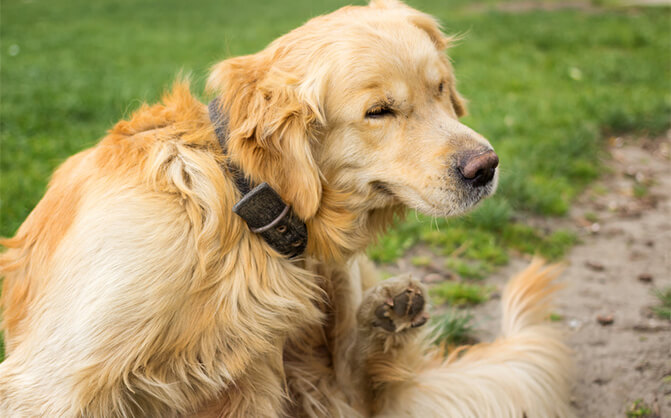Is your dog itchy more than usual? You suspect that your dog might have fleas, but you have no idea about what to look for? Well, undoubtedly, Fleas are annoying and challenging to get rid of. It would help if you were getting alarmed when you find an engorged flea absconding with your dog’s blood. There are many great reasons for keeping these varmints off your dog. Your dog gets threatened when he gets attacked by fleas and ticks.
Fleas belong to a class of common parasites that can make your dog uncomfortable and itchy. This flea population thrives in warm temperatures and humid weather conditions, and unfortunately, your furry pals are their favorite victims.
It is actually very important to know if your dog has fleas. Otherwise, these “Dog flea infestations” can rapidly affect even humans also. This issue escalates into a more serious problem for your faithful friend.
Dog fleas & illnesses they cause:

The dog flea is an ectoparasite that survives by sucking the blood of its host. It latches on the skin of dogs and other mammals. These fleas multiply so quickly that is why catching them early before their growing population. These fleas cause some severe illnesses in dogs such as:
- Anemia
- Babesiosis
- Ehrlichia
- Flea Allergic Dermatitis
- Hemobartonellosis
- Lyme disease
- Rocky Mountain Spotted Fever
- Tick paralysis
Dogs and puppies can pick up these irritating parasites easily through exposure to other animals. These fleas usually take temporary refuge to strike an invasion on your canine pet at any given opportunity. Sometimes you, as pet owners, become the cause of the problem. These bloodthirsty parasites find their way towards your pet dog.
How do fleas look like on a dog?
Fleas are tiny, and their size ranges from 1 – 2.5mm long, and the adult fleas have flat bodies with various colors from black to reddish-brown. These are wingless parasites with the extraordinary ability to cover a considerable distance with six long legs. These fleas are also able to evade your pet dog’s teeth and claws.
Is it easy to find fleas?

Usually, fleas are hard to find because of the length of the dog’s coat and the color of fleas. The thicker and darker fur of your dog can make it difficult to find fleas on your dog. Fleas move quickly and jump around; that is why they are not always easy to spot.
It is tough to find fleas with your naked eyes. That is why you have to rely on the presence of flea dirt to determine their presence on your dog. Flea dirt is nothing else but flea poop that appears as specks on the skin of your dog. These specks turn reddish-brown when they get wet, and it is a sign that your dog is dealing with fleas.
How can you find if your dog has fleas?

The behavior of your dog is the very first identification of the presence of fleas. In the next steps, you can perform a visual examination during grooming, and finally, you can observe signs of the fleas and their droppings in your environment for confirmation.
You have to keep in mind that the hot weather makes dogs more susceptible to getting fleas. Especially if your dog has to spend most of its time outdoors, you must check fleas regularly. If you find your dog is itching more than normal, it is advised to check them for any signs of fleas.
Here are significant signs of dog flea infestation that can help you to deal with the problem more effectively:
Restless behavior of your dog:
The continuous biting of fleas and possible allergic reactions due to the saliva of the parasite can cause a restless condition in your faithful friend. Dogs show excessive chewing or itching, head shaking, hot spots, or scabs.
Check for flea eggs and droppings:

Flea eggs and droppings can easily fall on the ground. Their eggs appear white in color and oval in shape while the droppings are like tiny black dots. These eggs and droppings look like granules of pepper and salt.
Performing a white towel test is also helpful in confirming the presence of fleas. Brushing your dog’s fur can agitate the fleas, and you should be able to spot these creepy parasites on a white towel easily.
Hair loss and allergic dermatitis:
Flea saliva causes itching, and it also shows an allergic reaction that manifests with more severe itching. The infected area gets red sores, and you can also observe hair loss patches. Allergic dermatitis is more severe in young puppies and older dogs. The hindquarters of dogs get the patterns of hair loss and allergy more prominently and especially along the tail and back legs.
Anemia & pale gums:
Pale gums could be a sign of anemia. The white or pale gums indicate blood loss due to fleas. The blood meal for a single flea is up to 15 times its body weight. This condition can be severe in small dogs and puppies. Listlessness and low body temperature are some other signs of anemia in pet dogs.
The appearance of tapeworms in dog feces:
The presence of tapeworms in your dog’s feces is another sign of the presence of fleas. Dog fleas may carry the larvae of tapeworms with them. When a dog licks or bites on the itchy part of its body, it may ingest some of its parasitic invaders along with a couple of tapeworm larvae.
These larvae grow into tapeworm inside your pet dog’s intestine and shed some of its parts into the waste products.
Conclusion:
It is so common that pet dogs encounter fleas and bring a coat full of them. The flea infestation appears to worsen only with time. Sometimes your house can be infested with fleas. The itching behavior of your pet is an alarming sign of the presence of fleas.
These tiny vampires can spell out disaster on your pet. Don’t be fooled by their minute size, are more capable of wreaking havoc into the lives of your pet and the entire family.
Unfortunately, your canine friend is helpless to solve this kind of problem on its own. This battle with fleas is like a race against time. You need to be attentive and have to take action to prevent the problem from escalating into a worse situation. The best solution to deal with the issue is to seek professional assistance from your local vet.